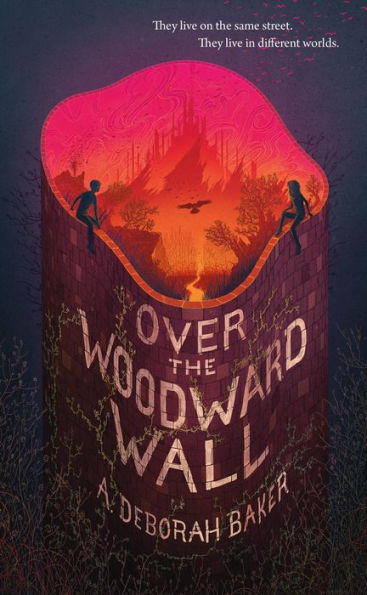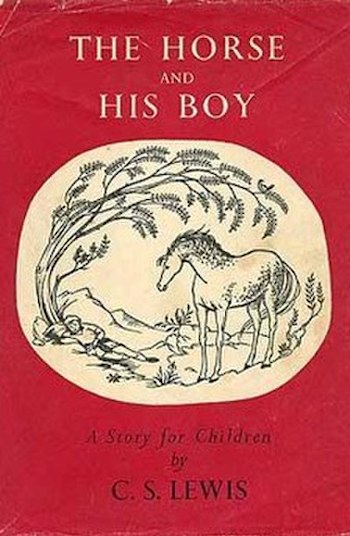C.S. Lewis loved horses. He once said, “I’d sooner have a nice thickset, steady-going cob that knew me and that I knew how to ride than all the cars and private planes in the world.” (He’s no Judith Tarr, though! Be sure to check out her excellent SFF equines series here at Tor.com!)
Lewis wrote the entirety of The Horse and His Boy in 1950. So this book, the fifth of the Narnia books to be published, was the fourth to be completed (The Silver Chair was written partially before, but finished afterward). It’s also the third chronologically, taking place during the final few pages of The Lion, The Witch, and the Wardrobe. He and his publisher considered a few other titles, including Shasta and the North, Narnia and the North, Over the Border, Cor of Archenland, The Horse Bree, and The Desert Road to Narnia. It seems to me they chose wisely.
We could spend a lot of time debating exactly what this book is about—much like The Silver Chair, it feels like a straightforward adventure book—but Lewis has kindly let us know in one of his letters that he sees this book being centered on “the calling and conversion of a heathen.” Which, oh boy, we’re going to need to unpack that in the posts to come!
The story centers on a young man named Shasta who has grown up in faraway Calormen, a vaguely medieval dream of Central Asia and the Middle East. He lives a life of near-slavery in a small hut until he discovers, by accident and on the eve of being sold into actual slavery, that there is a talking horse named Bree (full name Breehy-hinny-brinny-hoohy-hah) who desires to run away to Narnia, across the northern desert. Shasta jumps at the chance, and together they head for freedom and the dream of an enlightened medieval Europe that is Narnia. Along the way they encounter lions, meet a horse and her girl, escape jackals, and set out from the tombs of Tashbaan for life and freedom in the North.
Buy the Book


Over the Woodward Wall
There are a few topics of particular interest to pay attention to as we enter this story. One, notice the shift in Lewis’s presentation of the feminine in this book versus the other Narnia books. Something is certainly changing here. Marriage is talked about in a different way (still not particularly positive); Aravis takes on some interesting attributes as a hyper-competent young woman. We also get some important foreshadowing of what’s to come for dear Susan in The Last Battle. An interesting sidenote: Lewis dedicates this book to the children of his future wife, Joy Davidman. They had begun corresponding in January of 1950, and Lewis’s brother tells us that Jack thought of her as “a most interesting American woman” from that first letter. Lewis wrote the book before he knew her well, but had met her and the children by the time publication rolled around.
Interestingly, Ms. Davidman was a recent convert to Christianity, and it’s tempting to think the theme of this book might have been influenced by her letters. It’s unlikely, though, given the speed at which Lewis was writing and the freshness of their acquaintance. Nevertheless, we get a much different picture of Aslan in this book, as we see him through the eyes of some Calormenes and displaced Narnians who don’t know much about him. If you’ve never read this book before, be sure to flip through once you hit the end and study the ways that Aslan is presented and how he’s talked about by the Calormenes.
Pay attention, too, to Lewis’s treatment of race and ethnicity in this book. Obviously, this book isn’t a treatise on race, but there are some clear indicators of his thoughts about those heathens to the south of Narnia (it’s not all negative…Lewis is far too interested in literature and other cultures for that. So keep an eye out for the things he loves about Calormen as well.).
If you’re reading along with us, here are a few more things to watch for and note as you read The Horse and His Boy:
- This is a tale about conversion, which Lewis believes is the end result of honest exploration. Pay attention to how curious Shasta is, and how often he asks questions.
- Be watching for themes of twins, reflections, siblings, doubles, mirror images (like Shasta and Aravis, Bree and Hwin).
- Look out for the “split self”…partings and reunions, opposites coming together, and the appearance of a singular Person in more than one place at a time.
- If you haven’t read the story of Moses recently, your enjoyment of The Horse and His Boy will likely be enriched by a refresher—Shasta’s story echoes that of Moses.
- Lewis clearly spent some time re-reading the Arabian Nights stories when he was building Calormen. Be watching for some echoes of those stories.
- This is a book about messages, good news, stories, and the power of words. Pay attention to the enormous number of flowery speeches, and who gives them.
- Keep an eye on those Pevensie kids. This is the clearest we see their reign during the Golden Age of Narnia and there are some fun callbacks to the original book (including the story as understood by the Calormenes!).
As always, I look forward to the conversation with all of you. I am thankful for your insights, your comments, and questions. See you here in a couple of weeks. To Narnia and the North!
 Matt Mikalatos is the author of the YA fantasy The Crescent Stone. You can follow him on Twitter or connect on Facebook.
Matt Mikalatos is the author of the YA fantasy The Crescent Stone. You can follow him on Twitter or connect on Facebook.










